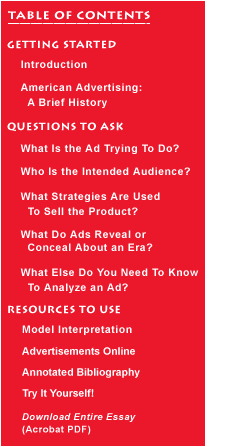talking history | syllabi | students | teachers | puzzle | about us

|
 |
|
Usually the ad is trying to sell a product, but this is only an initial response to the question. Does it aim to persuade readers to buy something for the first time or to switch brands? The tobacco industry, for example, has consistently maintained that its ads are aimed at maintaining brand loyalty or inducing smokers to switch. (Hence a prominent campaign a generation ago for a now-forgotten cigarette brand featuring models with bruises and black eyes saying “I’d rather fight than switch.”) Yet critics have noted the themes of youth, vitality, and pleasure in these ads and have exposed documents in which marketers strategize about attracting new smokers. What group did the advertisement try to reach? What publication did it appear in, with what kind of readership? Perhaps the most famous instance of a shift in target audience came in 1955, when the Leo Burnett agency revamped advertising for Marlboro cigarettes, formerly a minor brand marketed for their mildness and aimed at women smokers. Burnett introduced the Marlboro Man, models of rugged cowboys on horseback, smoking “a cigarette designed for men that women like,” in the words of the manufacturer’s ad director. Sales shot up immediately. Marlboro eventually became the world’s best-selling cigarette brand. And the Marlboro Man became one of the most widely-recognized (and reviled) advertising icons. What does the ad want the reader to do? Ultimately, of course, commercial advertising aims to win sales, but some advertisements seek primarily to gain the reader’s attention or stimulate interest in hopes that purchases will follow. On the other hand, repetitive ads for familiar products often aim to short-circuit the conscious consideration of purchase decisions. They try to stimulate the consumer to pick up the soft drink or the toothpaste or the detergent as she moves down the shopping aisles.
|
|

|
|

